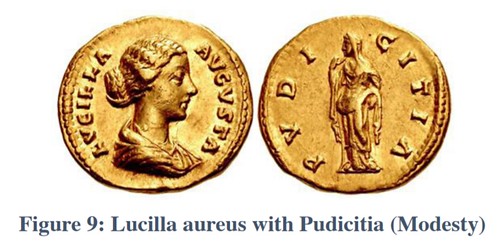
PREV ARTICLE
NEXT ARTICLE
FULL ISSUE
PREV FULL ISSUE
THE FIRST LADIES OF ROMEThe Summer 2020 issue of Classical Numismatic Review from Classical Numismatic Group, LLC has been published. Managing Director Mike Gasvoda wrote the following overview of the lead article. -Editor The introductory article by our own Julia Trocmé-Latter provides an enjoyable introduction to this important part of Roman coinage. Roman Empresses filled many roles in the Roman Empire, not unlike modern-day Presidential First Ladies. There are stark contrasts to their modern-day counterparts as well. But the importance of these First Ladies is implicit by the sheer numbers of coins struck in their honor. The extensive use of First Lady portraits on coinage comes to a zenith in the 2nd and 3rd centuries AD beginning with Faustina Senior and extending through the reign of Elagabalus. We have focused not only on exceptional portrait styles but have included many interesting reverse types as well. It is often through the reverse themes that we learn the most about how Roman rulers wanted to have their first ladies recognized. These reverses include virtues, family promotion, and occasionally specific references to glorify projects promoted by these first ladies. It is a fascinating area to study and collect. We hope you enjoy this special edition.
Here's a short excerpt and a couple selected images; see the complete article online - it's an excellent overview of the topic, and the issue features a large number of coins honouring important Imperial women. -Editor
Empresses in history and on coins By Julia Trocmé-Latter The very presence of imperial women on Roman coins speaks to the desire of the ruling dynasty to cast itself as an idealized Roman family. At this time, the most important public role for women was materfamilias, whose societal function was to bear and rear children (particularly sons) for the Empire. So, the decision to feature the wives of emperors on the imperial currency, even when heirs did not yet exist, served as a promise of dynastic continuity and stability.
Living women associated with powerful men had been appearing on Roman coins (as opposed to provincial coins, where the rules were more flexible) since the Second Triumvirate, but almost always disguised as goddesses or allegorical figures. Mark Antony's first wife Fulvia, who was very politically active, was portrayed as Victory on silver quinarii struck before her death in 40 BC. Octavia, Antony's next wife, appeared on provincially struck coins with her husband without any pretence of disguise (it helped that she was the sister of Antony's co-ruler Octavian and thus served as a symbol of their short-lived partnership). Still, the “disguised portrait” convention continued into the early Empire, with Augustus's daughter Julia depicted as Diana, or his wife Livia as the personification of Justice or Pax, as early examples. Caligula issued a sestertius with his three sisters on the reverse, all portrayed as allegorical figures considered appropriate for women (namely Securitas, Concordia, and Fortuna), but the identity of the three cannot be contained by their divine guises, as their names are unambiguously arranged around them.

To read the complete issue, see:

Wayne Homren, Editor The Numismatic Bibliomania Society is a non-profit organization promoting numismatic literature. See our web site at coinbooks.org. To submit items for publication in The E-Sylum, write to the Editor at this address: whomren@gmail.com To subscribe go to: https://my.binhost.com/lists/listinfo/esylum All Rights Reserved. NBS Home Page Contact the NBS webmaster 
|
